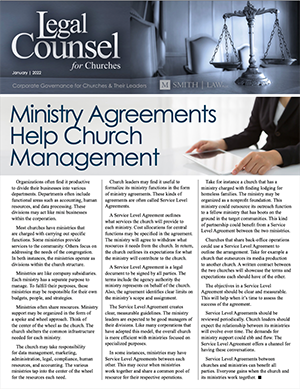Organizations often find it productive to divide their businesses into various departments. Departments often include functional areas such as accounting, human resources, and data processing. These divisions may act like mini businesses within the corporation.
Most churches have ministries that are charged with carrying out specific functions. Some ministries provide services to the community. Others focus on addressing the needs of the congregation. In both instances, the ministries operate as divisions within the church structure.
Ministries are like company subsidiaries. Each ministry has a separate purpose to manage. To fulfill their purposes, these ministries may be responsible for their own budgets, people, and strategies.
Ministries often share resources. Ministry support may be organized in the form of a spoke and wheel approach. Think of the center of the wheel as the church. The church shelters the common infrastructure needed for each ministry.
The church may take responsibility for data management, marketing, administration, legal, compliance, human resources, and accounting. The various ministries tap into the center of the wheel for the resources each need.
Church leaders may find it useful to formalize its ministry functions in the form of ministry agreements. These kinds of agreements are often called Service Level Agreements.
A Service Level Agreement outlines what services the church will provide to each ministry. Cost allocations for central functions may be specified in the agreement. The ministry will agree to withdraw what resources it needs from the church. In return, the church outlines its expectations for what the ministry will contribute to the church.
A Service Level Agreement is a legal document to be signed by all parties. The terms include the agency authority the ministry represents on behalf of the church. Also, the agreement identifies clear limits on the ministry’s scope and assignment.
The Service Level Agreement creates clear, measurable guidelines. The ministry leaders are expected to be good managers of their divisions. Like many corporations that have adopted this model, the overall church is more efficient with ministries focused on specialized purposes.
In some instances, ministries may have Service Level Agreements between each other. This may occur when ministries work together and share a common pool of resource for their respective operations.
Take for instance a church that has a ministry charged with finding lodging for homeless families. The ministry may be organized as a nonprofit foundation. This ministry could outsource its outreach function to a fellow ministry that has boots on the ground in the target communities. This kind of partnership could benefit from a Service Level Agreement between the two ministries.
Churches that share back-office operations could use a Service Level Agreement to outline the arrangement. Take for example a church that outsources its media production to another church. A written contract between the two churches will showcase the terms and expectations each should have of the other.
The objectives in a Service Level Agreement should be clear and measurable. This will help when it’s time to assess the success of the agreement.
Service Level Agreements should be reviewed periodically. Church leaders should expect the relationship between its ministries will evolve over time. The demands for ministry support could ebb and flow. The Service Level Agreement offers a channel for having these conversations.
Service Level Agreements between churches and ministries can benefit all parties. Everyone gains when the church and its ministries work together.

